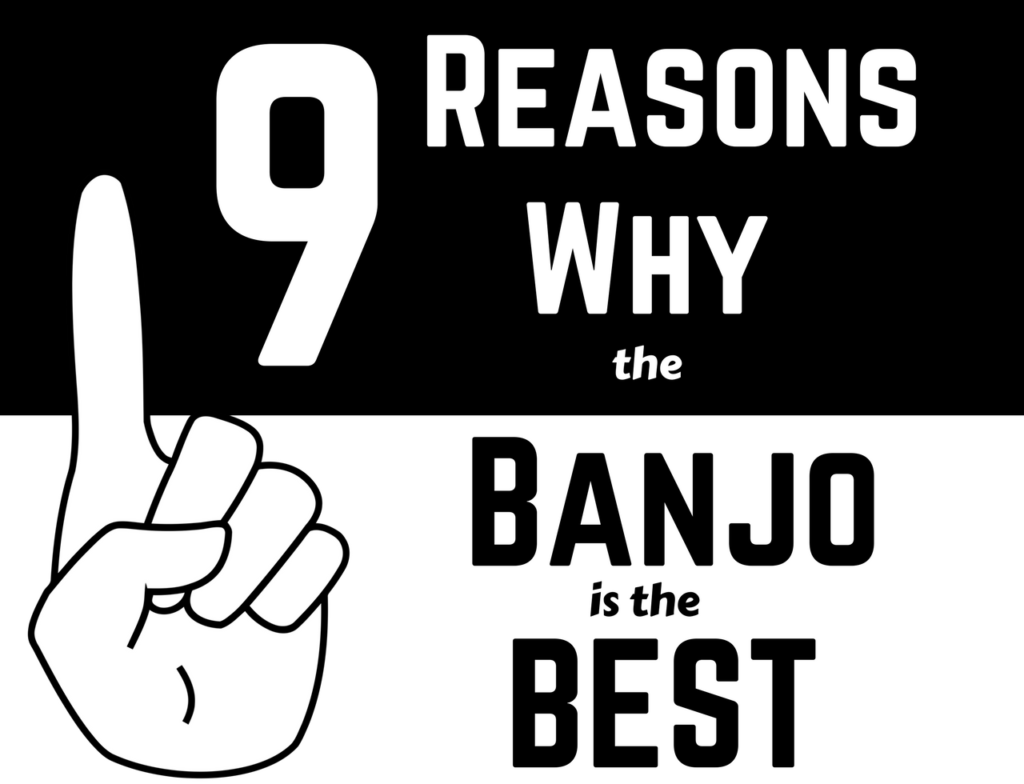
by Josh Turknett
Let me start by saying I love music in all forms. And I love all music making devices.
But I also have a special affinity for the banjo. In popular culture, however, misconceptions and mis-characterizations of our beloved 5-string abound.
So, in the interest of Banjo Public Relations, I thought it might be time to make the case for why I love the banjo, and why it is clearly the world’s greatest instrument.
Reason #1: THE SOUND
Any discussion of the 5 string banjo must begin with the sound.
Because there is nothing else like it.
And yet, while the joyful twang of a modern steel strung fingerpicked banjo is probably the first sound that comes to mind for most, the banjo is capable of so much more.
The ability to vary head tension, hand position, string type, head materials, bridge, tailpiece, playing techniques, nail length, neck woods, rim construction, and so on leads to a mind boggling number of potential sounds a banjo can make – even out of a single banjo. From sprightly and humorous to dark and melancholy, and everything in between.
(RELATED: Learn how to play the banjo clawhammer or fingerstyle with the Brainjo Method, the only system of instruction designed specifically for the adult brain. Click here for the Breakthrough Banjo course for clawhammer, or here to learn more about the Breakthrough Banjo course for fingerstyle.)
Reason #2: IT IS UNCONVENTIONAL
“When you find yourself on the side of the majority, it’s time to pause and reflect.”
– Mark Twain
Following the herd is tempting. It’s a survival instinct that, in our hunting and gathering days on the savannah, served us well.
In today’s world, where the consequences of zigging where others zag is almost never life threatening, the default strategy to do what everyone else is doing doesn’t always lead us where we want to go.
Almost without exception, the best decisions of my own life have been the unconventional ones – those times when I resisted the herd’s gravitational pull and set off in another direction.
And making one unconventional decision, like picking up the banjo over something more ordinary, helps to grease the wheels for more unconventional decisions to come. Until you’re crafting a life that may not fit the cookie cutter mold, but that fits you perfectly.
What this also means is that banjo players become banjo players just because they like the banjo.
Not because it’s what everyone else was doing (the guitar). Not because it’s what their parents wanted them to play (piano, violin). And certainly not to impress the ladies (the guitar again).
Plain, simple, and true.
Reason #3: IT DOESN’T CARE MUCH FOR ATTENTION.
There was the time – the “minstrel era” to be precise – when the banjo was all the rage. A time when the banjo player was the equivalent of the modern day electric-guitar-smashing rock star.
Times have changed.
In these times, the banjo is no longer in the spotlight. Its role is usually supportive, and we banjo players don’t mind that arrangement one bit.
It may be called on for the occasional solo, but that’s the exception that proves the rule. In most bands nowadays, the banjo’s main objective is to serve, to help everyone and everything sound a little bit better.
A banjo player can’t just mindlessly shred licks with the expectation her bandmates will keep up. No, to do his job well, a banjo player must focus on others just as much as he focuses on himself.
Even in the classic fiddle and banjo pairing the relationship is egalitarian. The object of the game is synergy, not a thinly veiled competition of one-upmanship.
Reason #4: YOU CAN TINKER WITH IT.
Tool making is hard wired into every human. We’re all born tinkerers.
We like to take stuff apart, mess around with it, figure out how it works, change things up and see what happens.
It’s how we learn about our world, and it’s how we ever came up with awesome ideas like a banjo in the first place.
Unlike most of its fragile cousins in the stringed instrument family, where doing anything more than a string change requires a certified professional, the banjo rewards the tinkering spirit. It’s infinitely customizable, resilient, and hard to screw up beyond repair.
Which also means that, as the tinkering continues, as people continue dreaming up novel modifications, the palette of potential sounds you can make on it will only continue to expand.
Reason #5: THERE’S NO FAME OR FORTUNE TO COME FROM IT.
First of all, playing music for a living is not the path to riches.
But for those who still decide to pursue a life of music for fame and fortune, or for attention from the opposite gender, the banjo is an ill-advised choice.
Which means that banjo players are pure of heart.
With no money to be made, no public adoration to be won, no girls to be wooed, all that’s left is just a desire to make good banjo sounds.
Reason #6: IT COMES FROM HUMBLE BEGINNINGS.
The banjo’s ancestors grew up in Africa.
Early forms consisted of a hollowed out gourd with animal skin stretched atop the strings, strung with animal gut, attached to a chunk of wood.
It’s been modified and transformed in many ways since, a tradition that continues to this day.
And there are essentially no rules about how to play it. Sure, some techniques work better than others, and have been passed along.
But there’s seemingly no end to the number of ways you can make great music on a banjo. And figuring out your own way of doing it is PART of the tradition.
Contrast this with an instrument like the violin, where the form of the instrument is precisely defined, and where the dominant pedagogy – arising from the dogmatic world of classical music, where uniformity is necessary to the style – says there’s one way of doing things.
Not surprisingly, this humble instrument tends to attract humble people.
Reason #7: IT IS MISUNDERSTOOD (like we all are)
“Frankly, there isn’t anyone you couldn’t learn to love once you’ve heard their story.”
– Fred Rogers (aka “Mister Rogers”)
There are more things misunderstood about the banjo than there are jokes about dentitionally challenged banjo players.
The banjo has deep roots in America. Especially in the South, where the history of the region and the banjo are intertwixed and intertwined. Over that long history, the banjo has come to mean different things to different people.
In popular culture, the banjo has been typecast. Most often, it’s used in the service of cheap jokes about ignorance and intolerance.
But that says more about us than it does about the banjo. After all, the banjo is just a thing. Whatever thoughts, emotions, and stories we map onto it exist in our imaginations. It’d be unfair to hold the banjo accountable for all that.
What’s more, those willing to take the time to dig deeper and truly understand the full story of the banjo are rewarded with one that’s far more interesting than the caricature presented in pop culture, and nearly its polar opposite.
Taking the time to get to know someone or something may seem anachronistic in our attentionally challenged culture of sound bytes, snapchats, and 160 character tweets, but it’s always worth the effort.
Reason #8: IT’S A COMPLETE MUSICAL SYSTEM
Melody and rhythm.
Like corned beef and cabbage, you can’t have one without the other. They’re the twin pillars of music.
Play the mandolin without a rhythm section and the absence is stark. Or play the drums without an instrument adding melody and the ears soon tire.
But listen to clawhammer banjo or old-time fingerpicking, and it’s all there. Melody and rhythm all wrapped into one captivating, gorgeous symbiotic unit. It’s a complete musical system.
It is a drum attached to a fretboard after all.
Reason #9: IT CONNECTS YOU TO A [VERY] LONG TRADITION.
Within America alone, the banjo has been a central member of many musical traditions, most of which predate the era of commercial music.
And while we don’t know when the first African tied strings across a skin-covered gourd, it’s likely that the traditions that included the banjo’s ancestors extend many centuries beyond that.
Needless to say, the banjo tradition spans continents and cultures. And almost universally, the banjo was played in celebratory rituals of song and dance. Back in times when we all made music, and didn’t divide ourselves into the performers and the audience, or the professionals and the amateurs.
For centuries, perhaps millennia, the banjo tradition has been handed down generation to generation, changing shape and sound along the way.
Playing the banjo connects you to all of that. You become one more link in a very long chain, a humbling reminder that you’re yet another traveler on this blue speck, with countless travelers who’ve come before, and many more still to come.
Sometimes it’s just nice to feel small.
To learn more about the Breakthrough Banjo courses for clawhammer and fingerstyle banjo, click the relevant link below:
— Breakthrough Banjo for CLAWHAMMER Banjo —
— Breakthrough Banjo for FINGERSTYLE Banjo —
— The Laws of Brainjo Table of Contents —
View the Brainjo Course Catalog
